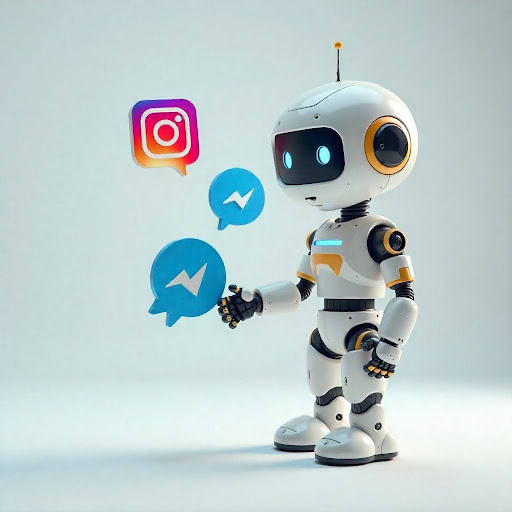Suppose that a customer sends a message about prices to your business at midnight on Instagram. The other one texts you via WhatsApp seeking to confirm an order. You would usually respond in the morning and possibly lose both leads. However, with chat automation, responses are automatically shared in real time 24/7. Features like WhatsApp automation make sure your customers never feel ignored.
This blog highlights the meaning and purpose of chat automation with its importance to social media. Let’s explore how it benefits your business by choosing the right chatbot automation.
What is Chat Automation?
Chat automation refers to setting automated chat flows within social sites. These flows respond to frequently asked questions, gather information such as emails or phone numbers, send updates on orders, and even convince customers to get closer to purchase. There are more advanced tools that use AI, yet even simple guidelines are effective in most cases.
In contrast to regular web chatbots, chat automation occupies the same space as your audience—Instagram DMs, Facebook Messenger, WhatsApp, and even TikTok or Telegram. This makes it more adaptable and useful, as it involves several platforms.
Why Does Chat Automation Matter for Social Media?
Social media moves fast. Customers require prompt responses, and time wastage is a wasted opportunity. Businesses can remain responsive with chat automation without any additional personnel.
It is reported that the automation decreases the number of messages handled by humans by 40 percent and enhances the response time. Thus, quick responses result in satisfied customers and increased conversion rates.
It also simplifies lead capture. Additionally, a new contact can be requested to provide an email, which can be stored and shared in a coupon, all without a human operator being involved, thanks to an automated WhatsApp flow. The outcome: additional leads, easier interactions, and decreased stress among support teams.
Where to Use Chat Automation — Platforms & Examples
- Facebook Messenger: Instant answers to FAQs, delivery updates, and quick responses to campaign queries.
- Instagram DMs: Auto-send product details when someone comments “price.” Example: comment → instant DM → product card with CTA.
- WhatsApp Automation: Send booking reminders, confirm orders, share shipping updates, or answer “Where is my order?” within seconds. Many businesses now use WhatsApp as their main customer channel because it feels personal and direct.
- TikTok: Newer options for creators and communities to engage followers through DMs.
The idea is simple: wherever people reach out, automation makes sure they never wait.
Benefits of Using Chatbot Automation
Following is the list of benefits of using chat automation.
Lead capture & list building
Turn casual chats into leads. Bots can share information, gather emails or phone numbers, and create subscriber lists to promote in the future.
24/7 customer support
Respond to FAQs and follow up on orders and confirmations at any time. Live agents can take complex issues and leave the customers happy without overwhelming your team.
Conversational commerce
Sell directly in chats. Put products on display, remind users about their carts, and remind users to make a purchase with personal and timely messages.
Appointment booking & reminders
Automate booking of salons, clinics or trainers. Bots share slots, minimize no shows, and save on staff time.
Campaign gating
Engagement: give an offer or a freebie. For example, you could run a Facebook campaign where people comment “DISCOUNT” on a post. The automation instantly sends a DM with a coupon code. Therefore, it enhances interaction and increases engagement while monitoring campaigns.
Best Practices to Use Chat Automation
Automation is most effective when it sounds like a dialogue. Write concise, step-by-step instructions and provide quick responses or buttons to choose.
Include a human handoff option always. To illustrate: when a WhatsApp user requires more complex assistance, a straightforward “Talk to an agent” button will make sure that they are not stuck in an endless loop.
Follow platform rules. WhatsApp, for instance, requires businesses to get consent before sending messages. Respect privacy and handle data carefully.
Finally, test often. Poorly designed flows can confuse customers. Monitor your automation, fix errors quickly, and keep improving. This way, automation builds trust instead of breaking it.
Quick Setup Checklist for Building Chat Automation
These are five simple steps to build chat automation.
- Choose your platform and tool: Start from a basic platform, e.g., WhatsApp or Instagram.
- Add the top 3 user intents: Like pricing, order updates, and appointment booking.
- Create a starter flow: Greeting → Qualifier → CTA (like a booking link).
- Add human touch: Always provide an option to give a personal touch.
- Track results: Track reply time and conversion rate for 30 days.
Conclusion
Chat automation doesn’t replace the team, but it acts as a team assistant. It responds to the common queries as human beings respond to the complicated ones. Particularly, the automation of WhatsApp is proving to be a business disruptor within companies that depend on quick, personalized communication.
The best way to start? Keep it simple. Pick one platform, set up one easy chat flow, and watch how it works. When you see the results, you can always add more.
Why wait? Try your first WhatsApp automation flow today and see the difference for yourself.
